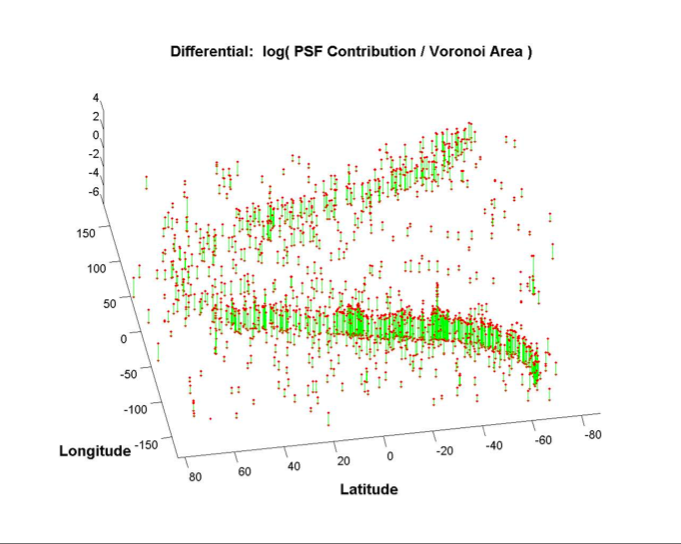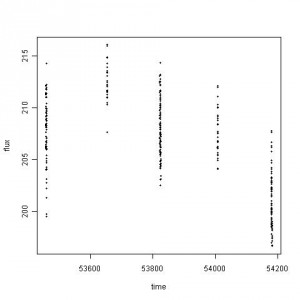Archive for the ‘gamma-ray’ Category.
Jun 21st, 2010| 12:25 pm | Posted by chasc
mini-Workshop on Computational Astro-statistics: Challenges and Methods for Massive Astronomical Data
Aug 24-25, 2010
Phillips Auditorium, CfA,
60 Garden St., Cambridge, MA 02138
URL: http://hea-www.harvard.edu/AstroStat/CAS2010
Continue reading ‘mini-Workshop on Computational AstroStatistics [announcement]’ »
Tags:
2010,
Announcement,
astronomical data,
astrostatistics,
Aug 2010,
August,
Computational,
workshop Category:
Astro,
CHASC,
gamma-ray,
Methods,
News,
Optical,
Stat,
X-ray |
Comment
Jul 12th, 2009| 07:33 pm | Posted by hlee
An email was forwarded with questions related to the data sets found in “Be an INTEGRAL astronomer”. Among the sets, the following scatter plot is based on the Crab data.
Continue reading ‘different views’ »
Tags:
ANOVA,
block design,
crab nebula,
F-test,
gaussinity,
integral,
light curve Category:
Astro,
Cross-Cultural,
gamma-ray,
High-Energy,
Jargon,
Objects,
Uncertainty |
Comment
Aug 27th, 2008| 07:50 am | Posted by vlk
UChicago, my alma mater, is doing alright for itself in the spacecraft naming business.
First there was Edwin Hubble (S.B. 1910, Ph.D. 1917).
Then came Arthur Compton (the “MetLab”).
Followed by Subramanya Chandrasekhar (Morton D. Hull Distinguished Service Professor of Theoretical Astrophysics).
And now, Enrico Fermi.
Tags:
CGRO,
Chandra,
Compton,
CXO,
Fermi,
GLAST,
HST,
Hubble,
observatory,
UChicago,
University of Chicago Category:
Astro,
gamma-ray,
High-Energy,
News,
Optical,
X-ray |
Comment
Jul 17th, 2008| 01:49 pm | Posted by chasc
A GLAST-related opportunity: A Summer Science Institute at SLAC on Cosmic Accelerators is scheduled for August 4-15 in anticipation of GLAST science, and the co-directors welcome participation by students, postdocs, and researchers (even those with no background in astrophysics). The registration deadline is July 31. Continue reading ‘SLAC Summer Institute’ »
Jun 8th, 2008| 09:45 pm | Posted by hlee
Despite no statistic related discussion, a paper comparing XSPEC and ISIS, spectral analysis open source applications might bring high energy astrophysicists’ interests this week. Continue reading ‘[ArXiv] 1st week, June 2008’ »
Tags:
black box,
catalog,
CMB,
confidence interval,
EGRET,
ICA,
ISIS,
maximum likelihood,
radio,
sample size,
student t,
XSPEC Category:
arXiv,
Data Processing,
gamma-ray,
High-Energy,
Methods,
Stat |
Comment
Aug 24th, 2007| 03:32 pm | Posted by vlk
Aug 16th, 2007| 06:34 pm | Posted by hlee
From arxiv/astro-ph:0705.3856
Gamma-ray albedo of the moon by Moskalenko and Porter
The title sounds very interesting although the significance of albedo spectra is not recognized by a statistician. This study was performed to utilize GLAST and PAMELA via Monte Carlo simulations (the toolkit for MC was GEANT 8.2) with EGRET data.
Aug 14th, 2007| 12:47 pm | Posted by hlee
From arxiv/astro-ph:0708.1510v1
Connecting GRBs and galaxies: the probability of chance coincidence by Cobb and Bailyn
Without an optical afterglow, a galaxy within the 2 arc second error region of a GRB x-ray afterglow is identified as a host galaxy; however confusion can rise due to the facts that 1. the edge of a galaxy is diffused, 2. multiple sources could exist within 2 arc second error region, 3.the distance between the galaxy and the x-ray afterglow is measured by projection, and 4. lensing causes increase of brightness and position shifts. In this paper, the authors “investigated the fields of 72 GRBs in order to examine the general issue of associations between GRBs and host galaxies.”
Continue reading ‘[ArXiv] GRB host galaxies, Aug. 10, 2007’ »
Tags:
afterglow,
false discovery,
GRB,
host galaxy,
lensing,
source matching Category:
arXiv,
Data Processing,
Galaxies,
gamma-ray,
Objects,
Uncertainty |
Comment
Aug 8th, 2007| 05:14 pm | Posted by hlee
X-ray summer school is on going. Numerous interesting topics were presented but not much about statistics (Only advice so far, “use implemented statistics in x-ray data reduction/analysis tools” and “it’s just a tool”). Nevertheless, I happened to talk two students extensively on their research topics, finding features from light curves. One was very empirical from comparing gamma ray burst trigger time to 24kHz observations and the other was statistical and algorithmic by using Bayesian Block. Sadly, I could not give them answers but the latter one dragged my attention.
Continue reading ‘Change Point Problem’ »
Tags:
ARCH,
Bayesian Block,
challenges,
change point problem,
GARCH,
light curves,
summer school,
X-ray Category:
Algorithms,
Bayesian,
Cross-Cultural,
Data Processing,
gamma-ray,
High-Energy,
Stat,
Timing,
X-ray |
4 Comments
Jul 25th, 2007| 03:22 am | Posted by hlee
From arxiv/astro-ph:0705.4020v2
Statistical Evidence for Three classes of Gamma-ray Bursts by T. Chattopadhyay et. al.
In general, gamma-ray bursts (GRBs) are classified into two groups: long (>2 sec) and short (<2 sec) duration bursts. Nonetheless, there have been some studies including arxiv/astro-ph:0705.4020v2 that statistically proved the optimal existence of 3 clusters. The pioneer work of GRB clusterings was based on hierarchical clustering methods by Mukerjee et. al.(Three Types of Gamma-Ray Bursts)
Continue reading ‘[ArXiv] Three Classes of GRBs, July 21, 2007’ »
Jul 16th, 2007| 12:15 pm | Posted by hlee
From arxiv/astro-ph:0707.1900v1
The complete catalogue of gamma-ray bursts observed by the Wide Field Cameras on board BeppoSAX by Vetere, et.al.
This paper intend to publicize the largest data set of Gamma Ray Burst (GRB) X-ray afterglows (right curves after the event), which is available from http://www.asdc.asi.it. It is claimed to be a complete on-line catalog of GRB observed by two wide-Field Cameras on board BeppoSAX (Click for its Wiki) in the period of 1996-2002. It is comprised with 77 bursts and 56 GRBs with Xray light curves, covering the energy range 40-700keV. A brief introduction to the instrument, data reduction, and catalog description is given.
Tags:
afterglow,
BeppoSAX,
catalog,
GRB,
light curve Category:
arXiv,
Data Processing,
gamma-ray,
Objects,
Spectral,
Timing,
X-ray |
1 Comment
Jul 5th, 2007| 04:13 pm | Posted by aconnors
 Jeff Scargle (in person [top] and in wavelet transform [bottom], left) weighs in on our continuing discussion on how well “automated fitting”/”Machine Learning” can really work (private communication, June 28, 2007):
Jeff Scargle (in person [top] and in wavelet transform [bottom], left) weighs in on our continuing discussion on how well “automated fitting”/”Machine Learning” can really work (private communication, June 28, 2007):
It is clearly wrong to say that automated fitting of models to data is impossible. Such a view ignores progress made in the area of machine learning and data mining. Of course there can be problems, I believe mostly connected with two related issues:
* Models that are too fragile (that is, easily broken by unusual data)
* Unusual data (that is, data that lie in some sense outside the arena that one expects)
The antidotes are:
(1) careful study of model sensitivity
(2) if the context warrants, preprocessing to remove “bad” points
(3) lots and lots of trial and error experiments, with both data sets that are as realistic as possible and ones that have extremes (outliers, large errors, errors with unusual properties, etc.)
Trial … error … fix error … retry …
You can quote me on that.

This ilustration is from Jeff Scargle’s First GLAST Symposium (June 2007) talk, pg 14, demonstrating the use of inverse area of Voroni tesselations, weighted by the PSF density, as an automated measure of the density of Poisson Gamma-Ray counts on the sky.
Category:
Algorithms,
Astro,
Data Processing,
gamma-ray,
High-Energy,
Imaging,
Methods,
Quotes,
Stat,
Timing,
X-ray |
1 Comment
Jun 6th, 2007| 02:24 pm | Posted by hlee
GLAST workshop will be held at Science Center (Hall A, located at the 1st floor) of Harvard University. Nice opportunity to learn about GLAST mission and its programs. Free registration and open to everyone. Please, visit
http://glast.gsfc.nasa.gov/workshops/boston/ for registration and further information.
May 30th, 2007| 11:11 am | Posted by hlee
John Rice is visiting IIC. The meeting and his talk is scheduled on Friday, June 8, at 11:30am (room 403 at 60 Oxford St.).
Title: Event Weighted Tests for Periodicity in a Sequence of Photon Arrival Times:
Detecting Gamma-ray Pulsars.
[Added] Another meeting is scheduled at the stat dept. located in Science Center, 4-6pm, Wednesday (June 6th).


